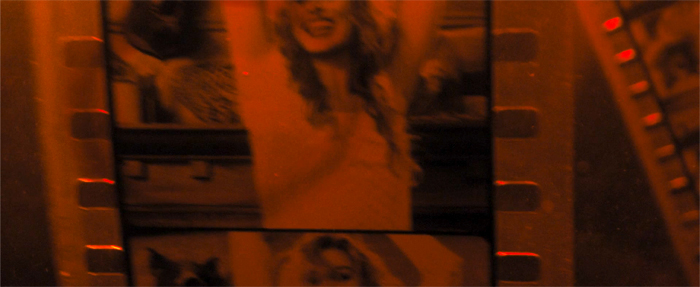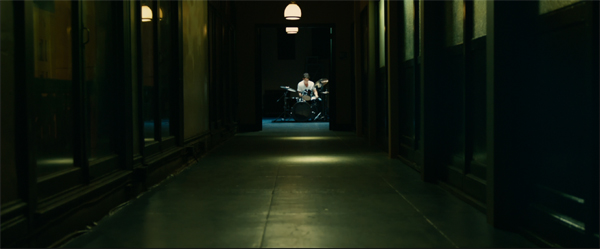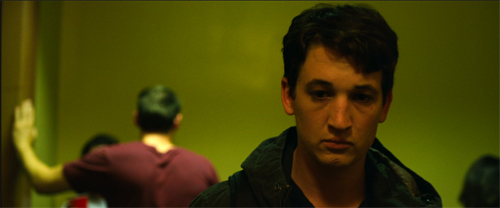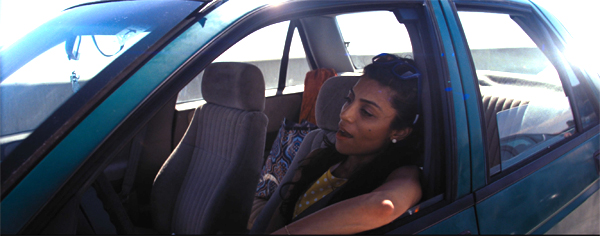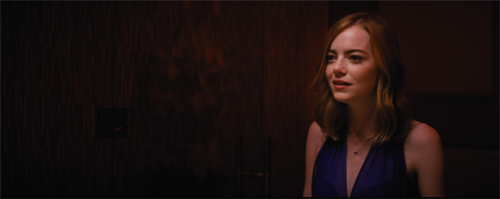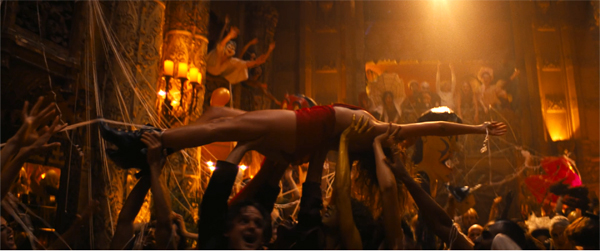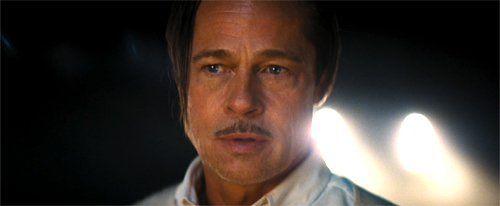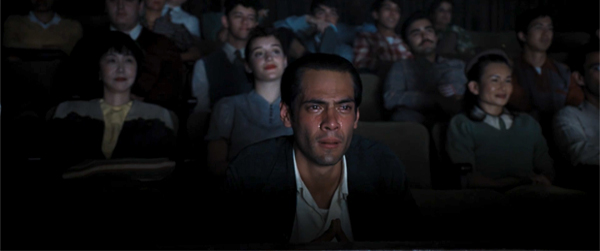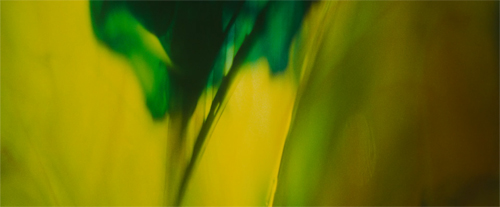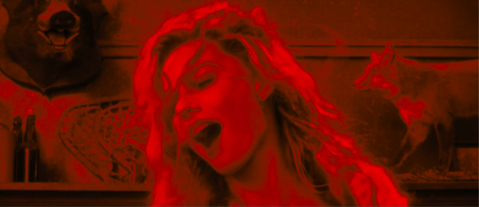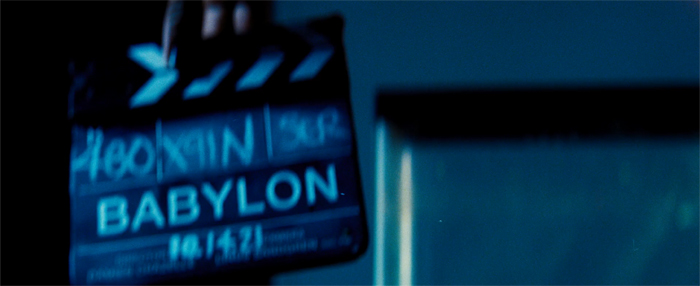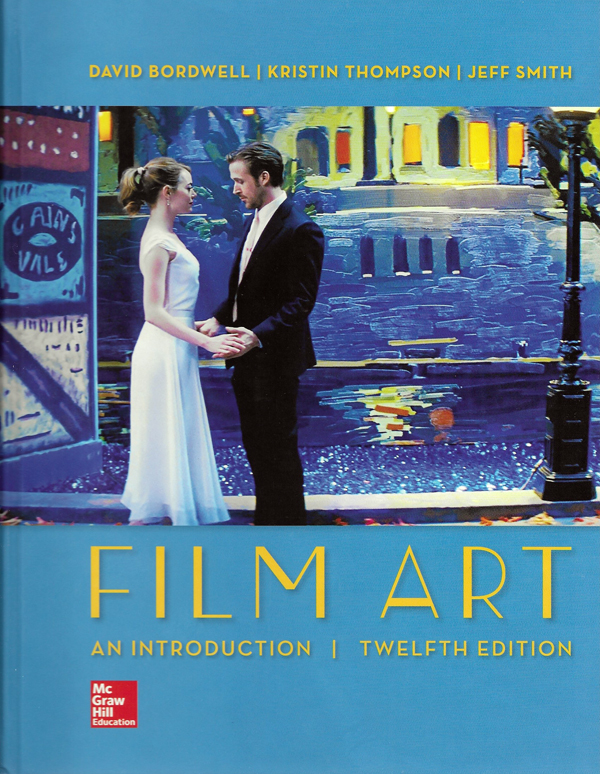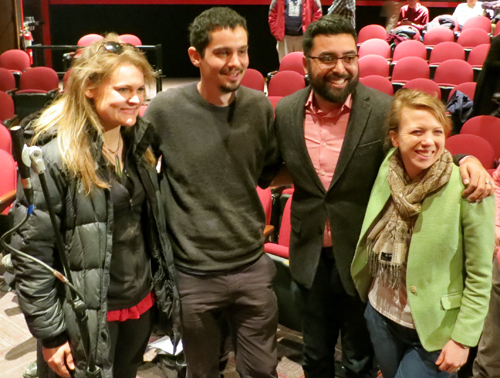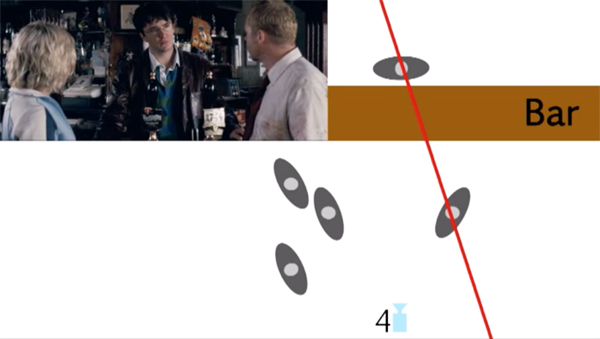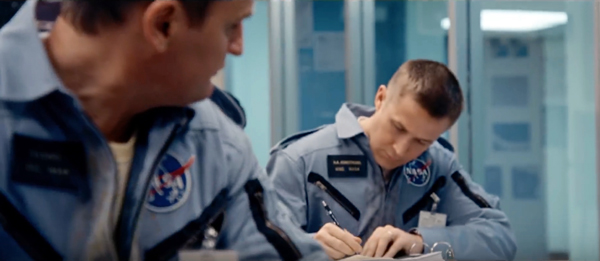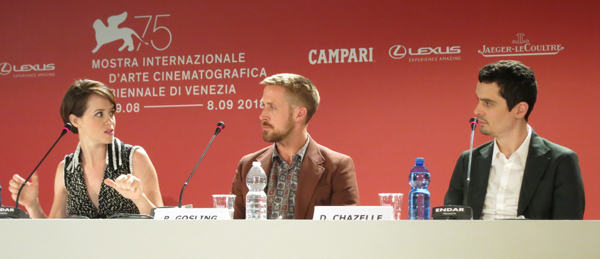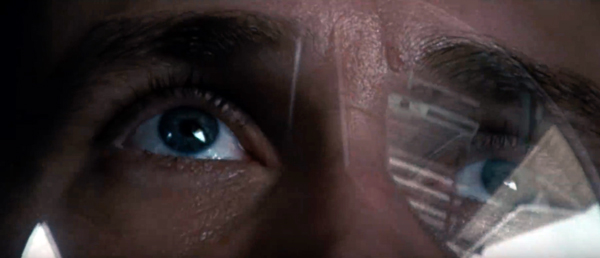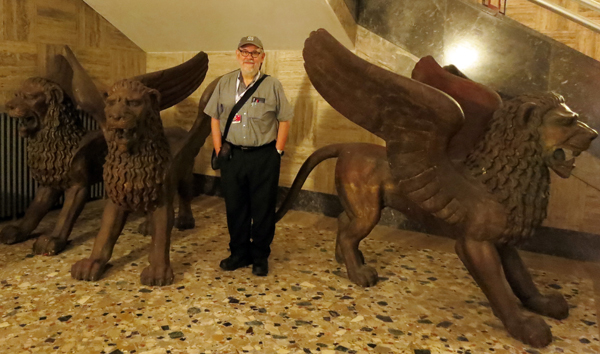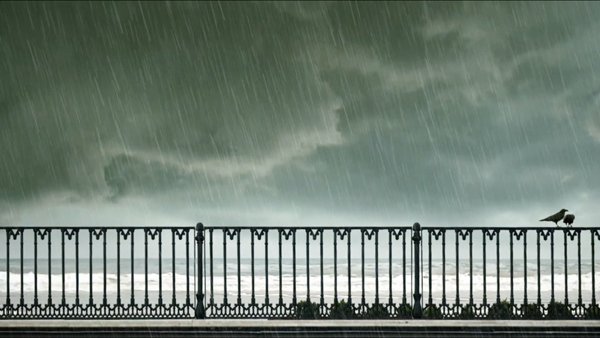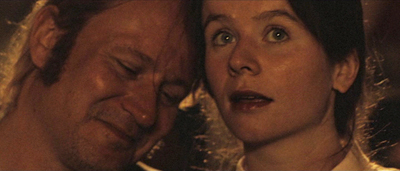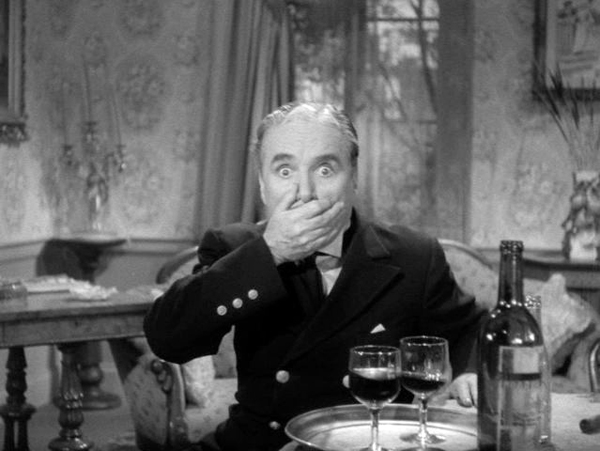Archive for the 'Directors: Chazelle' Category
BABYLON and the alchemy of fame
Babylon (2023).
DB here:
The circus parade has just passed, and behind it comes a little man mopping up all the droppings left by the lions, tigers, camels, and elephants. Somebody calls out, “Why don’t you quit that lousy job?”
The little man answers: “Are you kidding? And leave show business?”
From one angle, the joke anticipates the dramatic arc of Babylon. Damien Chazelle’s film traces how five characters seeking a future in the movies immerse themselves in a debauched culture, all for the sake of the dream machine.
For trumpeter Sidney Palmer and singer/actor Fay Zhu, the movie moguls’ bacchanals pay the bills and allow networking. Jack Conrad, a major star, loves being a drunken libertine but expresses contempt for the films he makes, movies that are only “pieces of shit” rather than innovative high art. Manuel Torres becomes an all-purpose gofer on set and eventually a studio executive, trying to work within the system. Nellie LaRoy is attracted to the movie world as much for the whirl of drink, drugs, dance, gambling, and fornication as for the glamor drenching the screen. Finding her film persona as the Wild Child, she can act by acting out.
These characters, all from working class origins, are brought together at a moment of technological upheaval: the period 1926-1934, with the establishment of talking pictures. This would seem to threaten moviemaking, not to mention the high life offscreen. Other pressures include the stock market collapse and the resulting depression, along with the establishment of a stricter standard of what could be depicted onscreen, the famous Hays Code. (The Code isn’t mentioned directly in Babylon, but it’s suggested as part of a broader concern with morality in the film colony.)
By the time sound has fully arrived, all of Babylon‘s primary characters, voluntarily or not, are no longer working in the Hollywood industry. Fay Zhu leaves for European production. Sidney, whose band is ideal for sound cinema, quits in disgust after he’s forced to darken his skin further. When the press and the public turn against Jack, he commits suicide. Nellie dances off into darkness and a lonely death. Manny, vainly in love with Nellie, can’t halt her self-destruction and has to flee town to avoid reprisals from the mob. From this angle, a confluence of debauchery and technology has wrecked whatever spark of life the system had.
The bleak satire that is Babylon poses a host of questions. Why, for instance, are there apparently deliberate anachronisms? The backdrop sets for the Vitoscope’s outdoor filming would be unlikely for 1926. Jack misquotes Gone with the Wind a decade before the book was published. The vast opening orgy seems more typical of Von Stroheim’s films than any actual Hollywood party on record. And given Vitoscope’s marginal status, how does the studio head afford such a mansion?
But I’m interested today in the ways the characters seek fame. I think their situations are a development of qualities we’ve seen in other Chazelle show-biz films. One way or another, nearly all those characters have sought to find a creative impulse that can make the compromise with a corrupt system yield some artistic rewards. The pressures and temptations of Babylon are extreme versions of factors we’ve seen at work in Whiplash and La La Land, but the characters react rather differently.
The suicidal drive for perfection
Whiplash (2014).
I think about that day
I left him at a Greyhound station
West of Santa Fé
We were seventeen, but he was sweet and it was true
Still I did what I had to do
‘Cause I just knew. . . .
These are the first lines we hear at the start of La La Land. Sung by a young woman slipping out of her car, they foreshadow the film’s plot developments. Sebastian and Mia, the couple at the center, both put their careers ahead of their love for each other and separate at the end. Each seeks success–Mia in screen acting, Sebastian in starting a jazz club–and that drive blocks a compromise in which one or both might give up their dreams for the sake of staying together.
Chazelle’s first two show-biz films present artistic achievement as a solitary quest that demands you to surrender normal ties to others. His strivers are loners, unable to subordinate their “dreams” to the demands of mutual love. Sacrificing everything to their quest, they have the self-righteous egocentrism of Romantic poets.
Whiplash tells the story of Andrew Neiman, an aspiring jazz drummer in music school. Worshipping Buddy Rich, he wants to be “one of the greats” himself. He spends hours in grueling solitary practice, and he has no friends. He is distant from his family, except for his father, with whom he goes to movies as if he were still a kid. He gives up a beginning romance with a young woman because, he tells her, he needs the time to practice.
The film introduces Andrew alone, bent over the drum kit, a distant figure in a corridor. In what follows, Chazelle isolates him, not through overwrought long shots showing him as remote from other students, but en passant, by medium shots that let us glimpse them in normal hallway conversation behind him.
Apart from competing with his peers, Andrew runs into Terence Fletcher, the fearsome leader of the school’s top jazz ensemble. Fletcher finds him practicing, invites him to try out for the band, and proceeds to run him through a program of brutal aggression, laced with just enough encouragement to keep Andrew on the hook. Good father/ bad father: the dynamic seems primal, but it’s an unequal struggle. Fletcher, always clad in satanic hipster black, knows how to dangle the prospect of success in front of Andrew’s bleary eyes.
That success comes in some degree, but haltingly. Andrew rises in the ranks, but through a series of unlucky mishaps, he humiliates himself in a major competition and assaults Fletcher onstage. He’s kicked out of school, but he’s also pressed to testify about his teacher’s abuse. It remains for Fletcher to entice Andrew one more time, tricking him into another public fiasco. Yet Andrew turns it into a sort of triumph.
Fletcher bullies Andrew into saying, “I’m here for a reason.” That reason, to put it in highfalutin terms, is the prospect of excellence within a worthy artistic tradition. To become as good as Buddy Rich is a wonderful prospect. But that’s a rosy picture. Breaking with Nicole, Andrew displays some of Fletcher’s cold-bloodedness, leading her to ask in her parting line, “What the fuck’s wrong with you?” She’s referring to his chopping off human ties, but she might as well be stressing Whiplash‘s suggestion that with that purity comes an eager masochism that is heightened by the master’s sadism. To be an artist is to sacrifice normal human ties but also to submit to a punishing game of power.
That game is played out in the career of Andrew’s idol. Buddy Rich, a technical virtuoso, had a combative view of musicianship. He conducted celebrated duels with other drummers and was said to have believed that for him, the drum was the solo instrument and the orchestra merely a batch of accompanists. As a bandleader, he was famous for vituperative attacks on his players. At once an obsessive like Andrew and a tyrant like Fletcher, he personifies the performer as a solitary seeker after inhuman perfection.
In what appears to be a burst of sincerity, Fletcher tells Andrew that the abuse he inflicts is solely to push the player to go beyond what’s expected. Only that will create the next Charlie Parker. Learning of the suicide of a student he tormented, he seems genuinely shaken–although he lies to his players by saying the boy died in a traffic accident. The sheer aggression that darkens his quest for quality is revealed when he deliberately sabotages his ensemble’s performance to make Andrew flub the piece.
At this point, though, Andrew catches some of Fletcher’s fury by launching into a maniacal solo. In its frenzied drive, it seems as if it could go on forever. By sheer force he wrests control of the orchestra from Fletcher, who seems with a smile to recognize what has happened and eventually plays along. He guides Andrew in a Rich-like descent into slower, then faster tempo. Reconciled with the strict father and the whiplashes he’s received, Andrew has demonstrated his heedless devotion to an exceptionally severe jazz tradition.
Music and machine
La La Land (2016).
Before it enacts the lovers’ separation foreshadowed in the opening song, La La Land gives us two protagonists aspiring to show-business success. Mia runs around town auditioning for TV shows, while Sebastian nurtures the dream of opening a jazz club. Like Andrew in Whiplash, Mia’s a loner with no deep relation with her peers. Sebastian, also a loner, harbors a conception of jazz playing that’s as combative as Buddy Rich’s. He explains a performance not as a communal exchange but as rivalry.
Look at the sax player right now. He just hijacked the song. He’s on his own trip. Every one of these guys is composing, they’re rearranging, they’re writing, and they’re playing the melody. And now the trumpet player, he’s got his own idea. And so it’s conflict and it’s compromise. . .
The game can get deadly. “Sidney Bechet shot somebody because they told him he played a wrong note.”
What drives the young and hopeful? The opening song suggests two impulses. First, there’s the fantasy realm of movies. “A Technicolor world made out of music and machine/ It called me to be on that screen/ And live inside each scene.” Second, there’s an urge to show the people back home that you’ve made it. “‘Cause maybe in that sleepy town/ He’ll sit one day, the lights are down/ He’ll see my face and think of how he/ used to know me.”
But neither purpose seems to be primary for Seb and Mia. True, Seb is a movie fan who quotes James Dean, but the couple aren’t apparently driven by fantasy. And although Mia comes from the sticks, she isn’t vindictive about it. Instead, they worry about succumbing to the mediocrity of the world they want to enter.
Jazz is dying, Sebastian laments. He plays at a piano bar and can’t introduce his own playlist. He picks up work as a keyboardist in an uninspiring but successful progressive-R&B ensemble. Mia auditions for clichéd roles and is facing a life as a barista.
The emptiness of their milieu is encapsulated in two party scenes. Unlike the infectious party in Guy and Madeline on a Park Bench (2009), these are scenes of careerist networking. Parties, Mia’s roommates argue, are essential for advancement; the person you schmooze today could hire you tomorrow (“Someone in the Crowd”). At the first party, confronted by snobs, Mia flees to the bathroom to confront herself in a mirror: Who is she really going to be? When she comes out, the party has become a sterile erotic tableau.
The alternative to giving people what they want is giving them you. Because Sebastian has found something of himself in jazz, he urges Mia to express herself in a one-woman show. She has her own tradition–the Hollywood movies her aunt showed her, and which she mimicked in skits she mounted as a girl. The show earns her an audition, where she channels her own experience in a song monologue about her aunt’s Paris adventures (“The Fools Who Dream”). It’s something of a reply to her mirror scene at the party. She gets the part, a lead to be built around her as a character.
Her successs and Sebastian’s steady if uninspiring life on tour initiate their breakup. Neither will sacrifice a career for a life together. Jazz may be conflict and compromise, but the only compromise visible here comes in the alternative time-frame climax showing the couple sharing domestic happiness. Somehow Mia has found stardom, with Seb as supportive spouse. But that’s a hypothetical outcome. As in Whiplash, you can achieve excellence by commitment to a personal tradition, but at the cost of close ties to others.
Party like it’s 1926
In the show-biz musicals, Chazelle’s protagonists’ goals aren’t defined as specific achievements–not winning a drumming prize but somehow becoming a drumming great, not getting a part in a particular show but getting some part in any show. Accordingly, like many off-Hollywood efforts, the films have episodic plot structures. Scenes tend to be more or less self-contained, with few dangling causes to lead to the next. Deadlines are set within a series of end-stopped scenes, not for the film as a whole. The action may be driven by coincidence, accident, and happenstance.
The episodic quality is less evident in Whiplash, whose scenes are dictated by scheduled rehearsals, solitary practice, and concert dates. Even there a flat tire, followed by a car crash, adds to the dramatic tension, and coincidence reintroduces Andrew to Fletcher after both have left the school. La La Land gives us a cascade of meet-cutes before the couple finally goes on a date. After that, their career trajectories depend chiefly on fortunate job offers, but also on Seb’s failing to remember a photo shoot. At the climax, a coincidental moment of traffic gridlock brings her and her beefcake husband back to the club to encounter Sebastian and the prospect of the future that might have been.
Moving from one protagonist to two to several in Babylon, Chazelle’s episodic inclination poses new problems. The major characters aren’t intimately connected, as in many network narratives. Manny is in love with Nellie, but he rarely sees her, and then only by accident. All are linked by being in the Hollywood system, and for the most part Chazelle is obliged to rely on crosscutting to interweave their developing careers.
The technique synchronizes their trajectories. Nellie is hired as actor at the first party, while Manny becomes Jack’s aide by escorting him home. The next day, as Nellie finds surprise success in her role for Vitoscope, Manny saves MGM’s costume picture by fetching a camera in time for a magic-hour shot. (The roots of Hollywood: a last-minute rescue.) Nellie’s rise to second lead is paralleled to Jack’s success in Blood and Gold, while Manny becomes Jack’s trusted assistant, sent to New York to catch the premiere of The Jazz Singer.
As the industry tries to assimilate sound, Nellie struggles and MGM hires Manny to supervise its Spanish-language production and coordinate musical shorts with Sidney’s band. Jack’s films start to bomb, Nellie’s star image goes out of style, and Manny rejoins Kinoscope to rehabilitate her. She remains a wild child, however, and Jack starts to realize his career is ending.
The storylines come to bleak endings when Jack commits suicide and Nellie drags Manny into her downward spiral, making them targets of James McKay’s mob. Once separated, Nellie vanishes and Manny flees the business. Sidney returns to playing live jazz for Black audiences, and his solo accompanies a montage sequence launched by Jack’s funeral and including a news story about Nellie’s 1938 death, possibly of a drug overdose.
To bring these protagonists physically together, Babylon relies chiefly on parties–five, by my count. The first and most sumptuous is an orgy hosted by Kinoscope’s boss Don Wallach. It demonstrates the dissipation of Hollywood culture. How could the comparative purity of Andrew or Mia or Sebastian survive this plunge into the mire? If nothing convinces one of the need to stand apart from the Hollywood milieu, this explosion of decadence should do it. Manny is a fixer (the guy sweeping up after the parade). Jack samples the fruits–a drink here, a quick copulation there–but Nellie is utterly in her element. She becomes the life of the party. If hedonism is an index of stardom, she shows, as she says, she was a star the moment she walked in.
At the party, Nellie and Manny explain why they’re attracted to this milieu. Manny says he wants to be part of something bigger, and he loves movies because they let you live the characters’ lives. Nellie agrees. Later, after she’s hired, she’ll holler that this will show everybody who said she was a loser. The two rationales–immersive fantasy and surprising the folks back home–are the same ones given in the opening song of La La Land. They have nothing to do with artistry in a tradition.
Jack’s case is a little different. He defends film as a high art, claiming that it needs a shot of modernism akin to Bauhaus design or twelve-tone music. Yet he has so little respect for his art that he plays his roles in an alcoholic stupor and condemns most films as shit. And claiming that sound would be as revolutionary as perspective in painting seems sheer silliness, especially after his joyless role in a regimented rendition of “Singin’ in the Rain.” In his longest tirade, he drops back to a mass-popularity argument. He tells his current wife that his immigrant parents found meaning in the nickelodeon, and millions more people will see him than will visit an O’Neill play.
You can argue that, like Mia in La La Land, Nellie and Jack succeed through self-expression. Nellie can cry on command because she remembers home; Jack cuts a dashing figure by his very nature. But they don’t work at their craft, or discipline their self-expression. Offscreen Nellie is a wastrel and Jack is a drunken pseud, babbling Italian, playing opera records, and garbling highbrow debates about mass culture and high art. Natural vitality gives Nellie and Jack some currency in the turmoil of silent film, but the discipline of talkies renders them obsolete.
They’re bereft of a tradition, though Jack senses the need for one. By contrast, Sidney has not only the jazz tradition but also, surprisingly, Scriabin. (Though in the Fletcher vein he admires Scriabin’s mutilation of his hands to play virtuoso passages.) It’s Sidney who quits the business out of principle. Not incidentally, he and Lady Fay seem the only protagonists with a powerful talents.
The second party, also hosted by Wallach, is somewhat more sedate than the first, though Nellie can be glimpsed nuzzling a unicorn’s horn. This initiates a montage that culminates in Nellie ecstatically watching her screen performance with an audience, who assail her for autographs.
The third party announces “Hooray for Sound” and brings together the three major characters in a night of frenzied activity. It’s reminiscent of the opening bacchanal, but seems more desperate, driving Nellie to break more bounds by daring death from a rattlesnake. (Lady Fay is the only partygoer bold enough to rescue her.) When Jack sees the melée that results, an uncharacteristically sustained and sober close-up, scored to a doleful piano, suggests that he senses that his milieu is headed for self-destruction.
Next party, far more upscale: Nellie tries to display her rehabilitation at a luncheon at a millionaire’s mansion. But her clumsy efforts to be genteel are mocked and so she lets loose with obscenity, attacks on food, and aggressive vomiting. Jack, Manny, Sidney, and FeiZhu have assimilated, but Nellie reverts to being the raucous low-life from Jersey. It’s career suicide. In parallel sequences we see Sidney forced into blackface and Jack frozen out by MGM.
The fifth party is a nightmarish descent into purgatory. “LA’s last real party,” McKay says as he ushers Manny and his colleague into a labyrinth of degenerate spectacle. Echoes such as the song “Her Girl’s Pussy” reveal the initial orgy as naive devilry: here is real shock. It’s as if the denizens of Hollywood have had their nerves rubbed so raw that only the most sadistic and gruesome entertainment will satisfy. Has this party been going all these years?
Taken all in all, it seems to me that the party sequences make explicit what the La La Land parties only suggested: to succumb to this milieu is fatal. The solitary quest of these lost souls render them vulnerable to temptations that will ruin them. In the Biblical Babylon, by pursuing false gods, the feasters have been weighed in the balance and found wanting. This is the story of people who think the party life (on the set of off) can last forever.
Granted, unlike Mia and Sebastian, the protagonists of Babylon have no other paths to their art. In the studio system, old-timers have assured us, you had to socialize with the decision-makers if you were to have a career. There were no equivalents of niche music clubs or indie film producers. In an odd way, Babylon is a roundabout tribute to the fluid artworld of today.
But then there’s the much-discussed final sequence.
Movies are bigger than ever
It’s 1952. Manny and his wife and daughter are visiting Los Angeles from New York, where Manny has a radio repair shop. As his wife and daughter return to their hotel, Manny drifts from the still-existent Kinoscope studio to a theatre. He finds himself in an audience watching Singin’ in the Rain. He sits transfixed, but his viewing is interrupted by a montage sequence that is, to say the least, a challenge to us.
What if the montage weren’t there? We’d have a scene in which Manny watches the new MGM movie restage the problems of early sound he witnessed, the tyranny of the mike and camera booth. He weeps. But then comes Kelly’s “Singin’ in the Rain,” which revises the mechanical chorus of old. Manny smiles. In his lifetime, the naive clumsiness of sound has been transmuted into something smooth and beautiful.
No wonder at the very end Manny is transported. He has achieved his hope of becoming part of something big. He has contributed to perfecting that imaginary world onscreen. We’d have what William Dean Howells claimed was the story all Americans wanted, “a tragedy with a happy ending.”
Hollywood has long justified its existence by appeal to magic. Disney provides the Magic Kingdom, while Lucas labeled his high-tech wizardry Industrial Light and Magic. At intervals throughout Babylon, characters echo the cliché. Jack calls a movie set the most magical place on earth; after his career has plummeted, he recalls the silent era in the same terms. The gossip columnist Elinor St. John celebrates “the camera’s magic tricks” in filming a battle. Without the inserted montage, Babylon‘s finale would confirm this mysterious magic, the way junk (the movies we see being made) can somehow become something splendid.
But we have that montage. Although it harbors many implications, it has the effect of sabotaging an upbeat ending. After a few shots recalling earlier scenes in the film (ending with the cliché of the couple passionately kissing), there’s a fusillade of images. They are snipped from silent cinema, abstract films, animation, widescreen splendors, foreign-language films, avant-garde films, computer films, CGI images, and wholly digital creations. Significantly, there are no Hollywood films represented from the 1930-1938 years we see in the last stretch of Babylon. It’s as if the visual narration is reminding us that the “something bigger” is indeed bigger than anything Manny experienced.
From one angle, it’s also a chronicle of technological change, all the “revolutions” that would follow the coming of sound. But where’s the magic? The usual counter to the mystique of magic is to point out the hard work of filmmaking. What delights us, on that account, is proficiency in craft and ingenious mastery of a tradition.
Chazelle floats another possibility. Having presented the digital future, he gives us luxurious images of dyes being mixed in colorful arabesques. Black-and-white footage is plunged into the brew.
What emerges are tinted versions of paradigmatic shots of the film we’ve seen: Nellie dancing on the bar, Jack on the promontory above the battlefield. Among more shots of the dyes mingling we see Sidney and Fay Zhu, now also tinted. The scenes we’ve seen have become part of silent film.
Bursts of pure color, interrupted by glimpses of live-action, close the montage.
The image is dissolved back into its most basic ingredients. A movie that started with a spray of elephant shit ends with streaks of translucent liquid sinuously circling one another. Movie magic, it seems, is a kind of alchemy, a distillation of molecular mixing within the hardware of filming, processing, and projection.
It’s tempting to take Elinor’s bleak consolation of Jack as the movie’s point: Long after he’s gone, future audiences will see him as a friend, at once an angel and a ghost. Perhaps the medium redeems anything it touches, lifting Nellie’s antics and Jack’s swagger to a luminous life everlasting. But this prospect negates the artistic premises of the two earlier films. Without a guiding passion to succeed through achievement, and with only an ebullient personality (Nellie) and some masculine grace (Jack) and a dutiful resourcefulness (Manny), have-nots can succeed in show business. For a while. When the parade is over, what’s left are spectral traces of its passing.
I have to say that decadent frescos like Babylon aren’t usually to my taste. I don’t much care for La Dolce Vita, Satyricon, The Damned, and comparable spectacles of luscious degradation. They have a moralistic, not to say moralizing tenor. But, as I tried to show here, liking or disliking a movie on grounds of taste doesn’t make the film uninteresting. A film can gain interest in the light of questions we can ask about its form, style, and themes (including political ones). On these grounds, the films by Fellini and Visconti remain important parts of the history of film, regardless of whether I find them sensationalistic. Similarly, while Babylon isn’t my favorite Chazelle film, I can appreciate its virtuosity, as in the frenzied crosscutting of the two 1926 shoots. I can also find its thematic inversion of his earlier work worth thinking about.
I don’t know what Chazelle the person thinks about artistic ambition and self-sacrifice. I do think that he has found a narrative model of the process that allows him to ask questions about whether creation is private or communal, self-expression or commitment to a tradition, ascetic denial or plunge into sensory distraction and self-exploitation. Most films never raise such questions.
On Buddy Rich’s style and career, I learned a lot from Jonathan Godsall’s article “Whiplash, Buddy Rich, and Visual Virtuosity in Drumkit Performance,” Twentieth-Century Music 19, 2 (2022), 283-309. Godsall is also good on how Chazelle’s cutting enhances Andrew’s performance.
Marya E. Gates offers a wide-ranging account of Babylon‘s references to silent-era filmmakers in this piece in Indiewire.
A helpful summary of the image-capsule montage at the film’s end is offered by Anthony Olesziewicz in Collider. Initially the sequence might seem to be Manny’s flashback, but the opening glimpses of his life in LA are quickly followed by examples ranging across film history, including years since 1952, which suggest a narrational commentary, like a footnote.
There are entries on other Chazelle films on this blog: La La Land (here and here) and First Man (here).
Babylon (2023).
Frisky at forty: FILM ART, 12th edition
DB here:
The first edition of Film Art: An Introduction rolled into an unsuspecting world in 1979. Its butterscotch jacket enclosed 339 pages of text and black-and-white illustrations. It was, I think, the first film studies textbook to use frame enlargements instead of production stills. It was definitely the first to argue for a systematic aesthetic of cinema integrating principles of form (narrative/nonnarrative) with style (techniques of the medium). Our goal, of course, was to enhance the readers’ appreciation of the range and power of film as an art form.
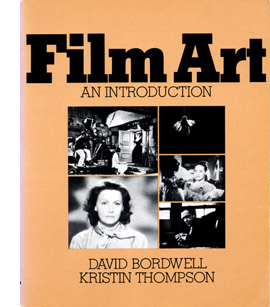 Not that there wasn’t a lot of room for improvement. Across three publishers–Addison-Wesley, then Knopf, and finally McGraw-Hill–the book has gained subtlety, precision, bulk, and color images. It now has a suite of online supplements in the form of aids for teachers and video clips for student reference, and the website you’re now visiting. Then there’s our streaming series on the Criterion Channel.
Not that there wasn’t a lot of room for improvement. Across three publishers–Addison-Wesley, then Knopf, and finally McGraw-Hill–the book has gained subtlety, precision, bulk, and color images. It now has a suite of online supplements in the form of aids for teachers and video clips for student reference, and the website you’re now visiting. Then there’s our streaming series on the Criterion Channel.
The core of our efforts remain the ideas and information we explore in the text. That material, happy to say, has found support among teachers, scholars, and writers of other textbooks. Through their suggestions and criticisms, we’ve had four decades to refine what Kristin and I initially set out, and on the eleventh edition Jeff Smith joined us to make things even better.
What’s new about this twelfth edition? Of course, we’ve updated it. We incorporate examples from Get Out, Son of Saul, mother!, Moonlight, Guardians of the Galaxy, Tiny Furniture, Inside Man, Wonderstruck, Dunkirk, Fences, Manchester by the Sea, Baby Driver, The Big Sick, Hell or High Water, Hostiles, A Girl Walks Home Alone at Night, The Blind Side, Opéra Mouffe, My Life as a Zucchini, Kubo and the Two Strings, Lady Bird, Birdman, The Lost World: Jurassic Park, Tangerine, A Ghost Story, Snowpiercer, The Grand Budapest Hotel, and other recent titles.
One of the biggest changes involves the addition of an analysis of social and political ideology in Ali: Fear Eats the Soul. This detailed look at Fassbinder’s melodrama of prejudice replaces our study of masculinity and violence in Raging Bull. That earlier piece will be posted for free access on this site, joining analyses from earlier editions on this page.
The most evident difference, signaled on the cover you see above, is a new case study of how a film gets made.
Production: The hows and whys
The book’s opening chapter,”Film as Art: Creativity, Technology, and Business,” matters a lot to us. We try to provide concrete, systematically organized information about how people work with technology and within institutions to implement the techniques we’ll survey in later chapters. At the same time, our discussion of production, distribution, and exhibition tries to show how filmmaking institutions shape creative choices about form and style. Perhaps because we try to make those choices down-to-earth, we’ve been pleased to find that Film Art is used in film production courses.
For several editions, Michael Mann’s Collateral served us well as a model of how decision-making in the production process shaped the final film. We thought, however, it was time to refresh that chapter, and La La Land provided us rich opportunities. We had already written blog entries (here and here) about aspects of the film, but we wanted learn more about how it had been created.
Made by a director not much older than our students, La La Land was perfect for a book that tries to be both up-to-date and sensitive to film history. From the burst of ensemble energy in the opening traffic jam to the parallel-reality ballet at the end, Damien Chazelle’s film was both contemporary and classical, what Kristin calls “a modern, old-fashioned musical.” We thought it would help students see that a young filmmaker can draw on tradition while staying firmly in our moment.
The film’s production decisions were well-documented, so we were able to trace four areas of creative choice. By considering the film’s mise-en-scene, camerawork, editing, and sound, we could set up the major stylistic categories to come in later chapters. For example, Jeff could point out unique features of Justin Hurwitz’s score.
We were lucky to get guidance from Damien himself. He reviewed our analysis, and then went far beyond the call of duty. He came to Madison to talk with our students (chronicled here). He sat for interviews with the Criterion Channel on Jean Rouch and Maurice Pialat. He did three Q & A’s. He even took snapshots with his fans.
And Damien energetically helped us secure rights to the cover image, a process that all writers of film books approach with fear and trembling. In short, he proved a total mensch. The fact that he had already read our work when we first contacted him encouraged us in the belief that we might be helping young filmmakers find their way.
Film Art wherever you go
Film Art is now available in a variety of formats and prices. The print edition is now a looseleaf, unbound one. Bound copies still circulate for rental. Students may also rent or buy the e-book edition, which comes packaged as a digital resource called Connect. It’s possible to merge some of these alternatives. The various options for getting the book are charted here.
The Connect package includes teaching aids for the instructor (self-tests, quizzes) and access to thirty-six film extracts, courtesy of the Criterion and Janus companies. There are also four fine videos on production practice by our colleague Erik Gunneson.
As I discussed at exhausting length when I previewed our new edition of Film History: An Introduction, the variety of formats for the book reflects not only changes in technology and the publishing market but also changes in consumer preferences.
However it’s accessed, Film Art: An Introduction still makes us happy. We’ve tried our hardest to help readers understand a bit more about the techniques and effects of cinema. As we point out in the book, thanks to smartphones everybody is a filmmaker now. We think that students’ hands-on experience prepares them for our efforts to understand the creative choices filmmakers have faced from the very beginning.
Thanks as ever to the staff at McGraw-Hill: our editor Sarah Remington and the team consisting of Danielle Clement, Sue Culbertson, Maryellen Curley, Joni Fraser, Ann Marie Jannett, and Elizabeth Murphy. Thanks as well to Kaitlin Fyfe and Erik Gunneson here at the Department of Communication Arts, UW–Madison. And of course thanks to Peter Becker, Kim Hendrickson, and their colleagues at Criterion.
Instructors who want to learn more about this edition can find a McGraw-Hill representative here.
Jeff Smith, who wrote the analysis of Ali: Fear Eats the Soul for our book, also provided an incisive discussion of staging in the film for our series on the Criterion Channel.
There’s a fuller account of how we came to write Film Art in our announcement of the previous edition.
Video supplement: Shifting the Axis of Action in Shaun of the Dead.
Venice 2018: First impressions, FIRST MAN

DB here:
Kristin and I are back at the Venice International Film Festival, because once more I’m on the panel for the festival’s Biennale College Cinema projects. A future post will take up those films, as well as Kristin’s comments on the restored Der Golem (1920), which screened the night before the festival’s official opening. For now, a quick report while we’re between screenings. And feel free to check in with our new Instagram page for rolling photo updates as the days go by.
First man, fourth feature
Kristin and I are admirers of Damien Chazelle’s work, so you’d expect that we were keen to see First Man, his Neil Armstrong film. It’s not exactly a biopic, as it concentrates on a fairly brief period of his life. It treats his career as an astronaut as partly a mechanism for coping with the death of his young daughter. The familiar Hollywood double plot–personal life versus professional life–is filled out by ongoing tensions with Armstrong’s wife Janet (Claire Foy) and by NASA’s efforts to beat the Russians to the moon.
The domestic scenes are steeped in mild melancholy, as the workaholic, buttoned-up Armstrong seems a good candidate for clinical depression. One powerful moment involves Janet’s insistence that he open up to his sons and admit that he might not return from the moon launch. His deep affection for his daughter, sketched quickly in the opening portions, suggests why he’s more stiff and distant with his sons later; it’s as if he doesn’t want to risk strong love again. Ryan Gosling’s performance handles this well, I think; after we’ve seen him caress his daughter’s hair early on, we watch his fingers closely. Even in long shots, his hands betray him, as when he nervously twists his wedding ring. (Below, Foy, Gosling, and Chazelle at the press conference.)
The moon mission becomes a kind of catharsis that lets Armstrong regain a dimension of his humanity. The professional plot, crystallized around a series of subgoals leading to the moon shot, renders him as tenacious and dedicated. Pointedly contrasted to showboating Buzz Aldrin, Armstrong’s laconic manner reflects not only a confidence in his abilities but a quiet, stubborn professionalism. This too is shaken by death; the incineration of his friends in a test not only stresses the danger of space flight but the fact that he is increasingly alone. Throughout his adversities, Armstrong must show both physical endurance and resourceful intelligence. He’s admirably swottish, but he uses it as a shield for emotions.
From its very opening frames First Man has a galvanizing immediacy. Chazelle has given up the smooth, locked-down camera technique of La La Land in favor of a looser handheld approach that recalls Guy and Madeline on a Park Bench. The film’s over 2000 shots create an impressionistic nervousness that suits not only the suspense of the NASA mission but the anxieties of the protagonist. DP Linus Sandgren filmed many of the tighter shots in Super-16mm, and the same gauge, applied to flashback images of Armstrong’s daughter, yield almost Kodachrome bursts of color. By contrast, the culminating scenes on the lunar surface, shot in Imax, contrast with the rest of the film’s texture by being rigorously stable, awe-inspiring framings.
In filming Armstrong’s tests and missions, Chazelle tackles what we might call the Raging Bull problem. Scorsese sought to distinguish each of Jake LaMotta’s prizefights through different techniques (slow-motion, optical POV, and the like). Chazelle does much the same. The film’s harrowing opening sequence is rendered in convulsive imagery from Armstrong’s point of view, trapping us in the cockpit with him as he manages to salvage a test flight. Later aerial sequences take us briefly outside spacecraft in varying angles, but I think the most majestic external views are saved for the climactic moon shot.
Paralleling this pattern, in the most claustrophobic passages thrashing grinding sounds rip through the theatre. By contrast, the moon landing is accompanied by Justin Hurwitz’s quietly triumphant waltz. This is definitely a film to be seen and heard on the biggest screen you can find.
As one measure of Chazelle’s interest in fine-grain detail, consider his powerful use of reflections. The astronauts’ helmets become both distorting windows and reflecting masks that capture the world outside. There’s striking imagery in the opening sequence of the horizon’s curvature bouncing off Armstrong’s helmet, while when we get to the moon, the landscape becomes a wraparound image blotting out the First Man’s face. At one point earlier in the film, I swear I saw the reflection of the moon in the iris of Armstrong’s eye. In any case, the final shot (no spoilers here) takes this pictorial motif to a new emotional pitch.
I want to write more about First Man, after I’ve seen it again and thought about it more; I hope as well to bring you information from Linus Sandgren about the cinematography. Still, I hope these notes convey my immediate appreciation for what Chazelle and his team have accomplished. First Man seems to me another exciting achievement by one of the most ambitious directors working today.
Revisit us for more blogging, We’ll be writing about Cuarón’s Roma, which we saw this morning, and The Other Side of the Wind, which we’re seeing in a few hours. I make these promises as partly a way to ensure that we actually do it!
Thanks to Paolo Baratta, Alberto Barbera, Peter Cowie, Michela Lazzarin, and all their colleagues for their warm welcome of us to this year’s Biennale.
Earlier entries devoted to Chazelle are here.
Grrr! DB in the wingéd lions’ den: They have several of these beasts on hand. This and press conference photo by Kristin.
Is there a blog in this class? 2018
24 Frames (2017)
Kristin here:
David and I started this blog way back in 2006 largely as a way to offer teachers who use Film Art: An Introduction supplementary material that might tie in with the book. It immediately became something more informal, as we wrote about topics that interested us and events in our lives, like campus visits by filmmakers and festivals we attended. Few of the entries actually relate explicitly to the content of Film Art, and yet many of them might be relevant.
Every year shortly before the autumn semester begins, we offer this list of suggestions of posts that might be useful in classes, either as assignments or recommendations. Those who aren’t teaching or being taught might find the following round-up a handy way of catching up with entries they might have missed. After all, we are pushing 900 posts, and despite our excellent search engine and many categories of tags, a little guidance through this flood of texts and images might be useful to some.
This list starts after last August’s post. For past lists, see 2007, 2008, 2009, 2010, 2011, 2012, 2013, 2014, 2015, 2016, and 2017.
This year for the first time I’ll be including the video pieces that our collaborator Jeff Smith and we have since November, 2016, been posting monthly on the Criterion Channel of the streaming service FilmStruck. In them we briefly discuss (most run around 10 to 14 minutes) topics relating to movies streaming on FilmStruck. For teachers whose school subscribes to FilmStruck there is the possibility of showing them in classes. The series of videos is also called “Observations on Film Art,” because it was in a way conceived as an extension of this blog, though it’s more closely keyed to topics discussed in Film Art. As of now there are 21 videos available, with more in the can. I won’t put in a link for each individual entry, but you can find a complete index of our videos here. Since I didn’t include our early entries in my 2017 round-up, I’ll do so here.
As always, I’ll go chapter by chapter, with a few items at the end that don’t fit in but might be useful.
[July 21, 2019: In late November, 2018, the Filmstruck streaming service ceased operation. On April 8, 2019, it was replaced by The Criterion Channel, the streaming service of The Criterion Collection. All the Filmstruck videos listed below appear, with the same titles and numbers, in the “Observations on Film Art” series on the new service. Teachers are welcome to stream these for their classes with a subscription.]
Chapter 3 Narrative Form
David writes on the persistence of classical Hollywood storytelling in contemporary films: “Everything new is old again: Stories from 2017.”
In FilmStruck #5, I look at the effects of using a child as one of the main point-of-view figures in Victor Erice’s masterpiece: “The Spirit of the Beehive–A Child’s Point of View”
In FilmStruck #13, I deal with “Flashbacks in The Phantom Carriage.”
FilmStruck #14 features David discussing classical narrative structure in “Girl Shy—Harold Lloyd Meets Classical Hollywood.” His blog entry, “The Boy’s life: Harold Lloyd’s GIRL SHY on the Criterion Channel” elaborates on Lloyd’s move from simple slapstick into classical filmmaking in his early features. (It could also be used in relation to acting in Chapter 4.)
In FilmStruck #17, David examines “Narrative Symmetry in Chungking Express.”
Chapter 4 The Shot: Mise-en-Scene
In choosing films for our FilmStruck videos, we try occasionally to highlight little-known titles that deserve a lot more attention. In FilmStruck #16 I looks at the unusual lighting in Raymond Bernard’s early 1930s classic: “The Darkness of War in Wooden Crosses.”
FilmStruck #3: Abbas Kiarostami is noted for his expressive use of landscapes. I examine that aspect of his style in Where Is My Friend’s Home? and The Taste of Cherry: “Abbas Kiarostami–The Character of Landscape, the Landscape of Character.”
Teachers often request more on acting. Performances are difficult to analyze, but being able to use multiple clips helps lot. David has taken advantage of that three times so far.
In FilmStruck #4, “The Restrain of L’avventura,” he looks at how staging helps create the enigmatic quality of Antonionni’s narrative.
In FilmStruck #7, I deal with Renoir’s complex orchestration of action in depth: “Staging in The Rules of the Game.”
FilmStruck #10, features David on details of acting: “Performance in Brute Force.”
In Filmstruck #18, David analyses performance style: “Staging and Performance in Ivan the Terrible Part II.” He expands on it in “Eisenstein makes a scene: IVAN THE TERRIBLE Part 2 on the Criterion Channel.”
FilmStruck #19, by me, examines the narrative functions of “Color Motifs in Black Narcissus.”
Chapter 5 The Shot: Cinematography
A basic function of cinematography is framing–choosing a camera setup, deciding what to include or exclude from the shot. David discusses Lubitsch’s cunning play with framing in Rosita and Lady Windermere’s Fan in “Lubitsch redoes Lubitsch.”
In FilmStruck #6, Jeff shows how cinematography creates parallelism: “Camera Movement in Three Colors: Red.”
In FilmStruck 21 Jeff looks at a very different use of the camera: “The Restless Cinematography of Breaking the Waves.”
Chapter 6 The Relation of Shot to Shot: Editing
David on multiple-camera shooting and its effects on editing in an early Frank Capra sound film: “The quietest talkie: THE DONOVAN AFFAIR (1929).”
In Filmstruck #2, David discusses Kurosawa’s fast cutting in “Quicker Than the Eye—Editing in Sanjuro Sugata.”
In FilmStruck #20 Jeff lays out “Continuity Editing in The Devil and Daniel Webster.” He follows up on it with a blog entry: “FilmStruck goes to THE DEVIL”,
Chapter 7 Sound in the Cinema
In 2017, we were lucky enough to see the premiere of the restored print of Ernst Lubitsch’s Rosita (1923) at the Venice International Film Festival in 2017. My entry “Lubitsch and Pickford, finally together again,” gives some sense of the complexities of reconstructing the original musical score for the film.
In FilmStruck #1, Jeff Smith discusses “Musical Motifs in Foreign Correspondent.”
Filmstruck #8 features Jeff explaining Chabrol’s use of “Offscreen Sound in La cérémonie.”
In FilmStruck #11, I discuss Fritz Lang’s extraordinary facility with the new sound technology in his first talkie: “Mastering a New Medium—Sound in M.”
Chapter 8 Summary: Style and Film Form
David analyzes narrative patterning and lighting Casablanca in “You must remember this, even though I sort of didn’t.”
In FilmStruck #10, Jeff examines how Fassbender’s style helps accentuate social divisions: “The Stripped-Down Style of Ali Fear Eats the Soul.”
Chapter 9 Film Genres
David tackles a subset of the crime genre in “One last big job: How heist movies tell their stories.”
He also discusses a subset of the thriller genre in “The eyewitness plot and the drama of doubt.”
FilmStruck #9 has David exploring Chaplin’s departures from the conventions of his familiar comedies of the past to get serious in Monsieur Verdoux: “Chaplin’s Comedy of Murders.” He followed up with a blog entry, “MONSIEUR VERDOUX: Lethal Lothario.”
In Filmstruck entry #15, “Genre Play in The Player,” Jeff discusses the conventions of two genres, the crime thriller and movies about Hollywood filmmaking, in Robert Altman’s film. He elaborates on his analysis in his blog entry, “Who got played?”
Chapter 10 Documentary, Experimental, and Animated Films
I analyse Bill Morrison’s documentary on the history of Dawson City, where a cache of lost silent films was discovered, in “Bill Morrison’s lyrical tale of loss, destruction and (sometimes) recovery.”
David takes a close look at Abbas Kiarostami’s experimental final film in “Barely moving pictures: Kiarostami’s 24 FRAMES.”
Chapter 11 Film Criticism: Sample Analyses
We blogged from the Venice International Film Festival last year, offering analyses of some of the films we saw. These are much shorter than the ones in Chapter 11, but they show how even a brief report (of the type students might be assigned to write) can go beyond description and quick evaluation.
The first entry deals with the world premieres of The Shape of Water and Three Billboards outside Ebbing, Missouri and is based on single viewings. The second was based on two viewings of Argentine director Lucretia Martel’s marvelous and complex Zama. The third covers films by three major Asian directors: Kore-eda Hirokazu, John Woo, and Takeshi Kitano.
Chapter 12 Historical Changes in Film Art: Conventions and Choices, Traditions and Trends
My usual list of the ten best films of 90 years ago deals with great classics from 1927, some famous, some not so much so.
David discusses stylistic conventions and inventions in some rare 1910s American films in “Something familiar, something peculiar, something for everyone: The 1910s tonight.”
I give a rundown on the restoration of a silent Hollywood classic long available only in a truncated version: The Lost World (1925).
In teaching modern Hollywood and especially superhero blockbusters like Thor Ragnarok, my “Taika Waititi: The very model of a modern movie-maker” might prove useful.
Etc.
If you’re planning to show a film by Damien Chazelle in your class, for whatever chapter, David provides a run-down of his career and comments on his feature films in “New colors to sing: Damien Chazelle on films and filmmaking.” This complements entries from last year on La La Land: “How LA LA LAND is made” and “Singin’ in the sun,” a guest post featuring discussion by Kelley Conway, Eric Dienstfrey, and Amanda McQueen.
Our blog is not just of use for Film Art, of course. It contains a lot about film history that could be useful in teaching with our other textbook. In particular, this past year saw the publication of David’s Reinventing Hollywood: How 1940s Filmmakers Changed Hollywood Storytelling. His entry “REINVENTING HOLLYWOOD: Out of the past” discusses how it was written, and several entries, recent and older, bear on the book’s arguments. See the category “1940s Hollywood.”
Finally, we don’t deal with Virtual Reality artworks in Film Art, but if you include it in your class or are just interested in the subject, our entry “Venice 2017: Sensory Saturday; or what puts the Virtual in VR” might be of interest. It reports on four VR pieces shown at the Venice International Film Festival, the first major film festival to include VR and award prizes.
Monsieur Verdoux (1947)












